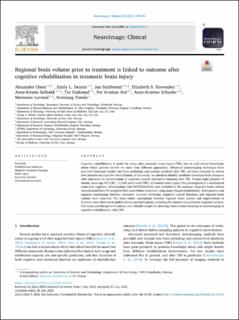| dc.contributor.author | Olsen, Alexander | |
| dc.contributor.author | Dennis, Emily L. | |
| dc.contributor.author | Stubberud, Jan Egil | |
| dc.contributor.author | Hovenden, Elizabeth S. | |
| dc.contributor.author | Solbakk, Anne-Kristin | |
| dc.contributor.author | Endestad, Tor | |
| dc.contributor.author | Hol, Per Kristian | |
| dc.contributor.author | Schanke, Anne-Kristine | |
| dc.contributor.author | Løvstad, Marianne | |
| dc.contributor.author | Tornås, Sveinung | |
| dc.date.accessioned | 2023-01-17T09:45:03Z | |
| dc.date.available | 2023-01-17T09:45:03Z | |
| dc.date.created | 2022-08-29T13:21:50Z | |
| dc.date.issued | 2022 | |
| dc.identifier.citation | NeuroImage: Clinical. 2022, 35 . | en_US |
| dc.identifier.issn | 2213-1582 | |
| dc.identifier.uri | https://hdl.handle.net/11250/3043891 | |
| dc.description.abstract | Cognitive rehabilitation is useful for many after traumatic brain injury (TBI), but we lack critical knowledge about which patients benefit the most from different approaches. Advanced neuroimaging techniques have provided important insight into brain pathology and systems plasticity after TBI, and have potential to inform new practices in cognitive rehabilitation. In this study, we aimed to identify candidate structural brain measures with relevance for rehabilitation of cognitive control (executive) function after TBI. Twenty-eight patients (9 female, mean age 40.5 (SD = 13.04) years) with TBI (>21 months since injury) that participated in a randomized controlled cognitive rehabilitation trial (NCT02692352) were included in the analyses. Regional brain volume was extracted from T1-weighted MRI scans before treatment using tensor-based morphometry. Both positive and negative associations between treatment outcome (everyday cognitive control function) and regional brain volume were observed. The most robust associations between regional brain volume and improvement in function were observed in midline fronto-parietal regions, including the anterior and posterior cingulate cortices. The study provides proof of concept and valuable insight for planning future studies focusing on neuroimaging in cognitive rehabilitation after TBI. | en_US |
| dc.language.iso | eng | en_US |
| dc.publisher | Elsevier Science | en_US |
| dc.rights | Navngivelse 4.0 Internasjonal | * |
| dc.rights.uri | http://creativecommons.org/licenses/by/4.0/deed.no | * |
| dc.title | Regional brain volume prior to treatment is linked to outcome after cognitive rehabilitation in traumatic brain injury | en_US |
| dc.title.alternative | Regional brain volume prior to treatment is linked to outcome after cognitive rehabilitation in traumatic brain injury | en_US |
| dc.type | Peer reviewed | en_US |
| dc.type | Journal article | en_US |
| dc.description.version | publishedVersion | en_US |
| dc.source.pagenumber | 11 | en_US |
| dc.source.volume | 35 | en_US |
| dc.source.journal | NeuroImage: Clinical | en_US |
| dc.identifier.doi | 10.1016/j.nicl.2022.103126 | |
| dc.identifier.cristin | 2046729 | |
| dc.relation.project | Norges forskningsråd: 262762 | en_US |
| cristin.ispublished | true | |
| cristin.fulltext | original | |
| cristin.qualitycode | 1 | |

